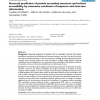Free Online Productivity Tools
i2Speak
i2Symbol
i2OCR
iTex2Img
iWeb2Print
iWeb2Shot
i2Type
iPdf2Split
iPdf2Merge
i2Bopomofo
i2Arabic
i2Style
i2Image
i2PDF
iLatex2Rtf
Sci2ools
BMCBI
2007
2007
Accurate prediction of protein secondary structure and solvent accessibility by consensus combiners of sequence and structure in
Background: Structural properties of proteins such as secondary structure and solvent accessibility contribute to three-dimensional structure prediction, not only in the ab initio case but also when homology information to known structures is available. Structural properties are also routinely used in protein analysis even when homology is available, largely because homology modelling is lower throughput than, say, secondary structure prediction. Nonetheless, predictors of secondary structure and solvent accessibility are virtually always ab initio. Results: Here we develop high-throughput machine learning systems for the prediction of protein secondary structure and solvent accessibility that exploit homology to proteins of known structure, where available, in the form of simple structural frequency profiles extracted from sets of PDB templates. We compare these systems to their state-of-the-art ab initio counterparts, and with a number of baselines in which secondary structures and ...
| Added | 12 Dec 2010 |
| Updated | 12 Dec 2010 |
| Type | Journal |
| Year | 2007 |
| Where | BMCBI |
| Authors | Gianluca Pollastri, Alberto J. M. Martin, Catherine Mooney, Alessandro Vullo |
Comments (0)

